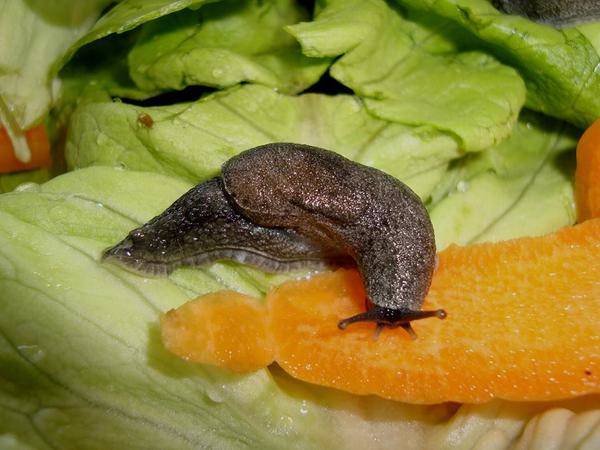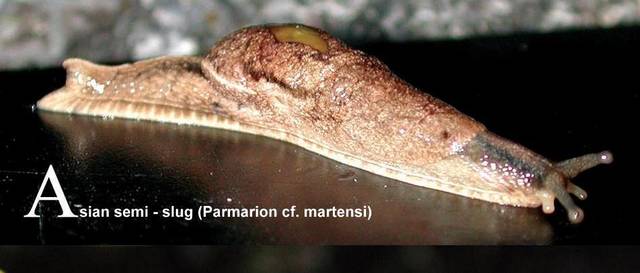Jeri asks: I recently heard that a case of rat lungworm disease was diagnosed in Kona. Since I grow lots of my own food, I’d like to know what I can do in my garden to avoid getting this disease.
Tropical Gardener answer: As you probably know, this disease (Angiostrongyliasis) is transmitted to humans through a microscopic nematode that slugs or snails consume if or when they eat droppings from rats that are infected with the parasitic nematode Angiostrongylus cantonensis. The adult form of A. cantonensis is only found in rodents.
It is important to know that, although rat lungworm disease can be very serious, it is relatively rare and with vigilance can be avoided. Meanwhile, you should not give up growing your own food or buying from growers or markets that you trust to be equally vigilant.
Though most cases here in Hawaii can be traced to contact with the Asian semi slug (Parmarion cf. martensi) the disease can be transmitted through other slugs or snails as well as some freshwater shrimp, crabs and frogs.
Since rats and slugs are common in Hawaii, reducing their population is an important first step in avoiding infection. Trapping rats or encouraging cats to hunt them can really help reduce their population.
Though you may not see a lot of snails or slugs during dry weather, they will come out once our summer rains begin. To see what you have on your property, fill shallow cans or dishes with beer. Drunken dead mollusks should be near your slug bar by the next day. You can also check moist areas on your property where they might be hiding. Under black plastic, cardboard, wooden boards, rocks, flower pots or fallen fruit is where you might find them. They also sometimes hide in rock walls. Once you find their hiding places, you can put out a pet safe (iron phosphate) slug bait in the area and can start collecting them. Be sure to wear gloves and/or use tongs to handle slugs and snails.
Smashing the slugs or snails does not kill the nematode. The best way to deal with the mollusks you find is to make a “slug jug” to put them in to die. A mix of about 7 parts water to 1 part salt will kill the slugs and the nematodes they harbor within 12 hours. Find a place on your property, away from plants, to dump the salty slug solution after the hunt.
The final practice that can help prevent rat lung disease is careful inspection and washing of your vegetables, especially greens. Holes eaten in the leaves of your greens might indicate slug damage. Cabbage worms and beetles also eat holes in leaves so do a thorough inspection before determining the cause. Look around the base and on the underside of the leaves for any slime trails, slug frass (poop), tiny eggs or baby mollusks. Any of these can contain the microscopic nematode. Even if you don’t see any indication of slug presence, be sure to wash all edibles under a strong stream of cold water as you do your final inspection.
Though this disease is scary, following these recommended practices can definitely help protect you and keep the occurrence of rat lungworm disease low.
Email plant questions to konamg@ctahr.hawaii.edu for answers by Certified Master Gardeners. Some questions will be chosen for inclusion in this column
Diana Duff is a plant adviser, educator and consultant living in a dryland forest north of Kailua-Kona.
Gardening Events
Saturday: “Work Day at Amy Greenwell Garden” from 9 a.m. to 12:30 p.m. Meet at the Garden Visitor Center across from the Manago Hotel in Captain Cook. Volunteers will be able to help with garden maintenance and are invited to bring a brown bag lunch. Water and snacks provided. Call Peter at 323-3318 for more information.
Farmer Direct Markets
Wednesday: “Hooulu Farmers Market” 9 a.m. to 2 p.m. at Sheraton Kona Resort &Spa at Keauhou Bay
“Sunset Farmers Market” 2-6 p.m. in the HPM parking lot, 74-5511 Luhia Street in
Kailua-Kona (across from Target)
Friday: “Pure Kona Market” 9 a.m. to 5 p.m. at Amy Greenwell Garden in Captain Cook
Saturday: “Keauhou Farmers Market” 8 a.m. to noon at Keauhou Shopping Center
“Kamuela Farmer’s Market” from 7 a.m. to noon at Pukalani Stables
“Waimea Town Market” from 7:30 a.m. to noon at the Parker School in central Waimea
“Waimea Homestead Farmers Market” from 7 a.m. to noon at the Waimea Middle and
Elementary School Playground
Sunday: “Pure Kona Green Market” 9 a.m. to 2 p.m. at Amy Greenwell Garden in Captain Cook
“Hamakua Harvest” 9 a.m. to 2 p.m. at Highway 19 and Mamane Street in Honokaa
Plant Advice Lines
Anytime: konamg@ctahr.hawaii.edu
Tuesdays &Thursdays: 9 a.m. to noon at UH-CES in Kainaliu – 322-4892
Mon., Tues. &Fri: 9 a.m. to noon at UH CES at Komohana in Hilo 981-5199 or himga@hawaii.edu









